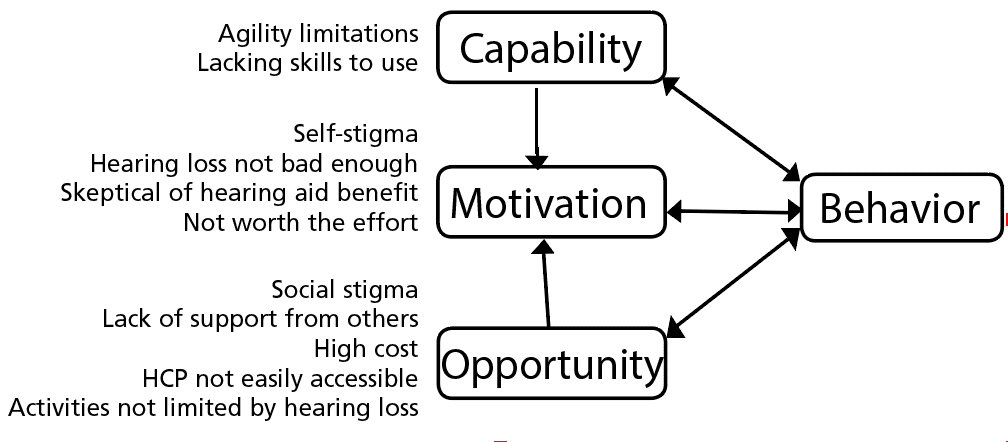SPECIAL SECTION: OTC HEARING AIDS
An introduction to this special feature package on Over-the-Counter (OTC) hearing aids
By Brent Edwards, PhD, and Melanie Ferguson, PhD
The COM-B model provides a framework for understanding factors that influence consumer behavior when purchasing hearing aids. While OTC hearing aids have been created to address the factors of affordability and accessibility, the model clearly suggests that consumers will continue to reject hearing aids until the other influencing factors are addressed.
About this month’s guest-editor: The Hearing Review thanks Brent Edwards, PhD, for guest-editing this month’s special edition about OTC hearing devices. Dr Edwards joined the National Acoustic Laboratories (NAL) in Sydney, Australia, as director in 2018 after more than 20 years of leading corporate hearing aid research and development teams involved in innovative signal processing algorithms, fitting procedures, diagnostics and outcome measures, wireless technologies, transducers, and more. He founded and developed the Starkey Hearing Research Center in Berkeley, Calif, later served as CTO at EarLens Corp across the bay in Menlo Park, Calif, and has published extensively in peer-reviewed journals and HR, as well as being an invited speaker at many international scientific conferences. Dr Edwards is involved in several audiological research organizations, and is an Honorary Associate Professor at the University of Nottingham’s School of Medicine. He received his BS degree in electrical engineering from Virginia Polytechnic Institute, his MS and PhD in electrical engineering and computer science from the University of Michigan, and was a Postdoctoral Fellow in psychology at the University of Minnesota. — Karl Strom, editor
The US Food and Drug Administration (FDA) is scheduled to publish its proposed guidelines for over-the-counter (OTC) hearing aids in August, although many believe the Covid-19 pandemic will cause FDA to delay its proposed regulations into the fourth quarter of 2020 or even into 2021 (see editor Karl Strom’s Staff Standpoint article on p 6). Whatever the case, hearing aids will soon be able to be legally sold directly to consumers with perceived mild-moderate hearing loss without the participation of hearing healthcare providers. This is the result of legislation passed by Congress in the Over-the-Counter Hearing Aid Act of 2017.1,2
When this occurs, hearing healthcare will likely undergo a significant inevitable transformation in the types of hearing aids that are delivered, the companies that produce hearing aids, the methods by which hearing aids are distributed, and the population of people who receive hearing aids. The specifics of this coming transformation and its extent and impact on the current hearing healthcare system, however, is unclear. What will OTC hearing aids be like? Which companies will successfully deliver OTC hearing aids? How will OTC hearing aids affect hearing care professionals (HCPs)? Who will purchase OTC hearing aids?
In this and the following papers, many of these questions are addressed. This article will discuss why people with hearing loss have been rejecting HCP-fit hearing aids and will suggest what is needed to be successful providing OTC hearing aids to this population. Dr Elizabeth Convery will review the challenges to being a successful user of OTC hearing aids (p 14). Dr Todd Ricketts will discuss the value that the hearing healthcare professional provides to acquirers of hearing aids that will be difficult to replace in an OTC delivery model (p 16). Finally, Dr Andrew Sabin will provide a vision for how OTC hearing aid technology will evolve and provide innovation to the marketplace (p 18).
COM-B Framework
A variety of health psychology models and frameworks have been developed to describe psychological, behavioral, and social factors that affect healthcare. These can be used to describe, for example, the reasons that people might not follow their diets and help identify ways to effectively motivate them to stick to their diets. These same frameworks can be applied to understand why someone with hearing loss would reject an HCP-fit hearing aid and help identify what interventions could get them to accept using hearing aids.
One comprehensive yet simple framework for describing influences to health behavior is the COM-B system.3 This contemporary, supra-theory model of behavior change defines Capability, Opportunity, and Motivation as the influencing factors that affect Behavior—hence, the name COM-B. The COM-B framework has been used as the basis for developing interventions to change behavior in a variety of healthcare areas, including eating behaviors,4 smoking cessation,5 hearing aid use,6 and smartphone-connected listening device use.7
The four boxes in Figure 1 demonstrate the COM-B framework, showing that not only can the capability/opportunity/motivation factors affect behavior but can also affect the factors themselves. For example, making a health treatment easier to access (improved Opportunity) could affect your desire to take part in the treatment (increased Motivation) and ultimately your decision to participate (change in Behavior).

The benefit of the COM-B framework is it guides us on what to consider as behavior influences, and also guides us on what actions we might take to try to change behavior—in this case, getting someone with hearing loss who currently rejects HCP-fit hearing aids to accept and wear hearing aids. Here, we consider each of the three factors in this context.
COM-B and Hearing Aid Acceptance
Capability is defined as an individual’s psychological and physical factors that affect the behavior under question. Physical reasons why someone may not have a hearing aid include dexterity issues preventing a person from being able to use a hearing aid. Psychological reasons that someone may not have a hearing aid include lacking knowledge, confidence, or cognitive skills to use and maintain these small and complicated devices.
Motivation is defined as the thought processes behind the willingness to enact the behavior, divided into automatic processes (that are instinctive, emotional, and impulsive) and reflective processes (that are deliberate and require evaluation and planning). Automatic motivations for not getting a hearing aid include embarrassment about wearing hearing aids and stigma over the idea that getting a hearing aid means that one is old and feeble. Reflective motivations for not getting a hearing aid are those reasons that have been thought through and the person concluding that they don’t want or shouldn’t get a hearing aid: belief that their hearing isn’t bad enough to warrant a hearing aid, skepticism towards the benefit that a hearing aid would provide, or simply deciding that a hearing aid isn’t worth the effort to see an HCP about their hearing difficulty.
Opportunity is defined as the factors outside of the person that influence their behavior, divided into social influences (norms, relationships, or cultural factors) and physical influences (environmental factors that allow or inhibit behavior). Social influences for not getting a hearing aid include social stigma associated with wearing hearing aids and lack of support from others to seek hearing help. Physical reasons for not getting a hearing aid include the high cost of hearing aids relative to one’s ability to pay for them, inconvenience of where HCPs are obtained, and the acoustic environments of a person’s activities such that their hearing loss does not affect participation.
We’ve summarize factors affecting someone’s decision to get a hearing aid in Figure 1. As new regulations are put in place and new device classes are allowed, these are the factors that need to be addressed by policymakers and manufacturers in order to change people’s behavior towards choosing not to get a hearing aid through an HCP.
Factors Affecting the Decision to Get a Hearing Aid under the COM-B Model
The COM-B model sits within a behavior change system, the Behavior Change Wheel, that includes categories for interventions and policies that can affect the components of behavior. This larger system identifies which intervention functions can affect which behavior components.3 For example, training techniques can be used to affect the Capability components of behavior (such as using training videos to improve people’s abilities to manage hearing aids8), while Persuasion techniques can be used to affect the Motivation components of behavior (such as a marketing campaign to promote the beneficial capabilities of hearing aids).
Conclusion
The OTC legislation was primarily motivated by the proposition that the reason a large number of people with hearing loss don’t wear hearing aids is due to issues with accessibility and affordability. OTC hearing aids are expected to increase hearing aid use by being more affordable and accessible than HCP-fit hearing aids.
As can be seen with the COM-B framework shown in Figure 1, these are but two of many factors that likely affect this population’s decision not to get hearing aids. Each individual with hearing loss will have their own combination of factors that affects their current decision to not use hearing aids.9
Cheaper hearing aids available in retail stores or online will address an Opportunity factor that limits uptake, and may be a sufficient solution to change the behavior of some people who have been rejecting hearing aids. However, many people will continue to reject hearing aids until the other influencing factors shown in Figure 1 are addressed. Furthermore, once people have undertaken the first step in getting an OTC device, additional factors will likely arise that affect their usage behavior—factors that can also be identified with the COM-B framework, and then addressed.
The COM-B model provides a framework for understanding factors that influence the behaviors of someone with hearing loss throughout their hearing journey. In light of influencing factors identified with this framework, we should be able to identify the right care model for individuals in the process of getting access to hearing rehabilitation.
Correspondence can be addressed to HR or Dr Edwards at: [email protected].
Citation for this article: Edwards B, Ferguson M. Understanding hearing aid rejection and opportunities for OTC using the COM-B model. Hearing Review. 2020;27(6):12-13.

References
1. Warren E, Grassley C. Over-the-counter hearing aids: The path forward. JAMA Intern Med. 2017;177(5): 609-610.
2. President Trump signs OTC Hearing Aid legislation into law. https:// www.hearingreview.com/inside-hearing/legislation/ president-trump-signs-otc-hearing-aid-legislation-law. Hearing Review. Published August 19, 2017.
3. Michie S, Van Stralen MM, West R. The behaviour change wheel: A new method for characterising and designing behaviour change interventions. Implement Sci. 2011;6(42).
4. Atkins L, Michie S. Designing interventions to change eating behaviours. Proc Nutr Soc. 2015;74(2):164-170.
5. Gould GS, Bar-Zeev Y, Bovill M, et al. Designing an implementation intervention with the Behaviour Change Wheel for health provider smoking cessation care for Australian Indigenous pregnant women. Implement Sci. 2017;12(114).
6. Barker F, Atkins L, De Lusignan S. Applying the COM-B behaviour model and behaviour change wheel to develop an intervention to improve hearing-aid use in adult auditory rehabilitation. Int J Audiol. 2016;55[Sup3]:S90-S98.
7. Maidment DW, Ali YHK, Ferguson MA. Applying the COM-B model to assess the usability of smartphone-connected listening devices in adults with hearing loss. J Am Acad Audiol. 2019;30(5):417-430.
8. Ferguson M, Brandreth M, Brassington W, Leighton P, Wharrad H. A randomized controlled trial to evaluate the benefits of a multimedia educational program for first-time hearing aid users. Ear Hear.2016;37(2):123-136.
9. Kochkin S. MarkeTrak VIII: The key influencing factors in hearing aid purchase intent. Hearing Review. 2012;19(3):12-25.
Other Articles in the OTC Hearing Aids Special Section series below:
Tech Trends in OTC Hearing Aids
Meeting the Challenges of OTC: Who Are Self-fitting Hearing Aids Really For?
Individualizing Hearing Healthcare: New Opportunities in OTC Hearing Aids




